Itami Airport
Itami Airport Osaka International Airport 伊丹空港 大阪国際空港 Itami Kūkō Ōsaka Kokusai Kūkō | |||||||||||||||
|---|---|---|---|---|---|---|---|---|---|---|---|---|---|---|---|
 | |||||||||||||||
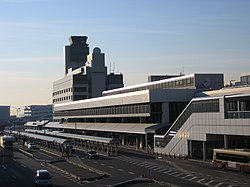 | |||||||||||||||
| Summary | |||||||||||||||
| Airport type | Public | ||||||||||||||
| Owner | New Kansai International Airport Company (NKIAC)[1] | ||||||||||||||
| Operator | Kansai Airports (Orix and Vinci Airports) | ||||||||||||||
| Serves | Keihanshin | ||||||||||||||
| Location | |||||||||||||||
| Opened | 1939 | ||||||||||||||
| Hub for | |||||||||||||||
| Elevation AMSL | 39 ft / 12 m | ||||||||||||||
| Coordinates | 34°47′04″N 135°26′21″E / 34.78444°N 135.43917°E | ||||||||||||||
| Website | www | ||||||||||||||
| Map | |||||||||||||||
 | |||||||||||||||
| Runways | |||||||||||||||
| |||||||||||||||
| Statistics (2015) | |||||||||||||||
| |||||||||||||||
Source: Japanese Ministry of Land, Infrastructure, Transport and Tourism[2] | |||||||||||||||
Osaka International Airport (大阪国際空港, Ōsaka Kokusai Kūkō) (IATA: ITM, ICAO: RJOO), often referred to as Itami Airport (伊丹空港, Itami Kūkō), is the primary regional airport for the Kansai region of Japan, including the major cities of Osaka, Kyoto, and Kobe. It is the airport closest to Kyoto, 36 km (22 mi) southwest of Kyoto Station. Itami Airport has a small footprint, covering only 311 hectares (768 acres) of land.[3]
Despite its "international" designation, the airport caters exclusively to domestic flights. Kansai International Airport (43 km (27 mi) away) took over the region's international traffic in 1994 and competes with Itami for domestic traffic. Itami also faces competition from Kobe Airport (26 km (16 mi) away), a smaller domestic airport opened in 2006.
The airport was named after the city of Itami, Hyōgo Prefecture, because most of its land is located there. A portion of the airport property is also located in Toyonaka and Ikeda cities of Osaka Prefecture. The terminal complex is located in all three of these cities, and the only access from the Itami side is via a long tunnel that passes below the runway and apron.
In FY2006, Itami used to be Japan's third busiest airport and the Kansai region's busiest. In 2015, it had 139,450 aircraft movements, serving 14,541,936 domestic passengers and carrying 140,668 metric tons of freight cargo.[4] In 2018, Itami was the seventh busiest in Japan, serving 16.3 million passengers. In the Kansai region, Kansai International Airport had far more passengers than Itami Airport.
History
[edit]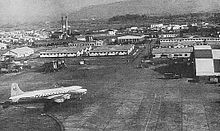
Itami Airport opened as No. 2 Osaka Airport (第二大阪飛行場, Dai-ni Ōsaka Hikōjō) in 1939. Prior to the opening of Itami, Kizugawa Airport was Osaka's main civilian airport. It handled both seaplanes and conventional ones. The site of Kizugawa Airport is now a port area in Funamachi in south end of Taisho Ward with only a small marker[5] located in Funamachi Ryokuchi Park below the Shin-Kizugawa Bridge.
In 1931, the Osaka municipal government drafted plans to construct a new "No. 1 Osaka Airport" near the mouth of the Yamato River, also targeted at seaplanes, but concerns about fog and protests from Kobe-based businesses led the government to build the "No. 2 Airport" for land-based aircraft instead.[6]

Construction began in July 1936 on a 53-hectare (131 acre) site. The new airport was primarily used by the Imperial Japanese Army during its early years. U.S. occupation forces took over Osaka Airport after the end of World War II in 1945, expanding it to 221 hectares and renaming it Itami Air Base.[7] The airfield was used extensively by US forces during the Korean War.[8] In 1954, Marilyn Monroe and Joe DiMaggio stopped at Itami during their honeymoon, and in 1956, the base was used in the filming of the movie Sayonara.
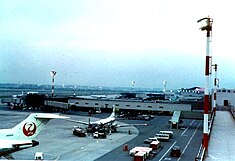
Itami was renamed Osaka Airport (大阪空港, Ōsaka Kūkō) following its return to Japanese control in March 1959. The Japanese government quickly implemented a plan to expand the airport by an additional 82.5 ha so that it could accommodate jet aircraft. Despite some protests from locals, the plan was approved by the neighboring city assemblies between 1960 and 1961 with strong backing from local business groups, and land was purchased between 1962 and 1964, in part out of the aviation industry's interest in keeping pace with the development of the Tokaido Shinkansen high-speed rail link between Tokyo and Osaka. The main runway was completed in 1970.[8]
International era (1950s-1994)
[edit]
In its heyday Itami was served by a variety of major international carriers, including Pan Am (Japan routes transferred to United in 1985), British Airways, Air India, Cathay Pacific and Korean Air. Northwest Airlines was a major international operator at Itami, and by 1992 offered nonstop service to New York, Los Angeles, Honolulu and Sydney.[9] The Sydney service became the focus of a rare aviation agreement dispute between the United States and Australia, as less than 30% of passengers on the Australia-Japan segment were originating in the U.S. even though the "primary objective" of the route authority, according to the US-Australia aviation agreement, was service between the US and Australia. In 1993, after Australia demanded arbitration and the US implemented retaliatory sanctions against Qantas, Northwest was forced to limit the amount of local Australia-Japan traffic on the Osaka-Sydney route, and subsequently abandoned the service entirely.[10] B.O.A.C also operated in Osaka until 1974, flying from either Taipei or Tokyo.[11]
Political friction
[edit]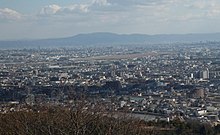

While Japan's economy was growing rapidly, the area around Itami Airport became an increasingly dense residential area for commuters to Osaka.
A number of factors made the airport an intensely debated political issue in the 1960s and 1970s, among them:
- The introduction of jet aircraft made noise and air pollution a growing concern among locals.
- The United States Armed Forces had rights to use Itami Airport for refueling and maintenance, and frequently sent military aircraft there for overhauls at the Shin Maywa Industries plant there. This activity caused consternation among locals who were opposed to the Vietnam War. [citation needed]
Jet flights at Itami began on June 1, 1964, and triggered complaints by neighboring residents about noise pollution.[8] In addition, eminent domain procedures were used in 1966 to obtain land for the runway expansion at Itami and led to local protests, as had also been the case in the construction of Narita International Airport near Tokyo.[12]
In May 1968, a group of local citizens decided to sue the government for damages related to noise pollution from Itami Airport. The lawsuit was filed in December 1969. The Japanese government concurrently banned takeoffs and landings at Itami between 10:30 PM and 6:30 AM, effective February 1970.[8]
In February 1974, the Osaka District Court issued a qualified ruling in favor of the plaintiffs which limited the scope of their damages. The plaintiffs appealed to the Osaka High Court, which ruled in November 1975 that the plaintiffs were entitled to both a wider scope of damages and an injunction halting flights at the airport between 9 PM and 7 AM. This was a landmark decision in Japanese environmental law as it set a precedent for polluters to be enjoined and to be required to pay damages to victims. However, the state then appealed to the Supreme Court of Japan, which deliberated for almost six years before ruling in 1981 that the High Court injunction was illegal (though the victims remained entitled to damages).[8]
By the mid-1970s, the airport was subject to extensive slot restrictions, with operations limited to 200 jets and 170 propeller aircraft per day, and no takeoffs or landings allowed after 9 PM. [citation needed] These restrictions led the major domestic airlines to adopt more widebody aircraft in ultra-high-density configurations on Itami routes. The introduction of these widebodies caused additional concern among locals who protested the increased pollution and greater dangers in the event of a crash. [citation needed]
Domestic era
[edit]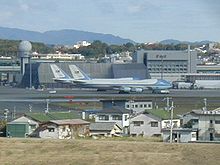
Because of the political friction surrounding Itami, planners began work in the 1970s to relocate many of its flights to an offshore location. This plan led to the opening of Osaka's current international airport, referred to as Kansai International Airport, in 1994 on an artificial island in Kansai region.[12]
There were originally plans to close Itami Airport following the opening of Kansai, but nearby communities opposed such a move for economic reasons, so Itami was retained as a domestic-only airport after Kansai opened in 1994. Itami has been used by international charters for state visits – Air Force One visited Itami in November 2005 and Chinese premier Wen Jiabao landed at Itami in April 2007[13] – and by Asiana Airlines charter flights to and from South Korea in late 2015.[14] All Nippon Airways retains a large maintenance base at Itami which occasionally services aircraft ferried in from overseas without passengers, and some international cargo flights continue to use the airport as well.
The policy of the Japanese government has been to limit operations at Itami in order to spur development at Kansai and Kobe.[15] Commercial passenger aircraft with more than two engines were banned from Itami effective April 2006, although such aircraft may continue to make ferry flights to and from Itami for maintenance purposes. All Nippon Airways flew a 747 to Itami on January 12, 2014, the first 747 operation at the airport in eight years, for an open house event to commemorate the upcoming retirement of ANA's 747 fleet in March 2014.[16]
The government proposed changing Itami's status from first-class airport to second-class airport, which would saddle local governments with one-third of its operating costs; after protests from the surrounding local authorities, the national government withdrew this proposal. The government also proposed banning widebody aircraft from Itami, although this proposal was criticized as unrealistic given the volume of traffic there.
In May 2011, the Diet of Japan passed legislation to form a new Kansai International Airport Corporation using the state's existing equity stake in Kansai Airport and its property holdings at Itami Airport. The move was aimed at offsetting Kansai Airport's debt burden.[17] NKIAC started free shuttle bus service between Itami and Kansai for transfer passengers in order to further integrate the two as a single hub. Itami has also seen increased domestic passenger traffic in 2013 following the easing of flight restrictions, which was possible due to propeller aircraft being replaced by quieter regional jets; JAL was able to increase the frequency on its Itami-Fukuoka route from two flights to five flights daily, making the route more competitive with the Sanyō Shinkansen rail service.[18]
In September 2013, NKIAC announced that it would acquire Osaka Airport Terminal Co. for 27.8 billion yen, which an NKIAC official called the "last piece" of the integration of both airports' management.[19] NKIAC plans to market Itami Airport to business travelers by touting its convenience for domestic business travel and improving its connectivity to Narita International Airport, while continuing to market Kansai Airport to leisure and international travelers.[20]
Following Typhoon Jebi, which resulted in the temporary closure of Kansai Airport in September 2018, operating hours at both Itami and Kobe were extended, and the government began considering permitting international service at all three Osaka area airports.[21] Japan Airlines later announced that it would operate two special flights between Itami and Hong Kong in mid-October 2018.[22] These would be the first scheduled international passenger flights to or from Itami in 24 years.[23]
Plans
[edit]Itami is limited to domestic flights, and can only handle 18 landings per hour and 370 landings per day. As of July 2013[update], NKIAC is considering providing more leniency to the aforementioned restrictions through negotiations with local authorities, on the basis that advances in technology have allowed modern aircraft to be quieter than those in operation when the restrictions were imposed. NKIAC hopes to coordinate with local governments to increase the number of slots allowed during the day and to open additional slots during nighttime hours.[15]
Both Hyogo Prefecture and Itami City are supporters of expanded service at Itami, and established a formal coordination body in July 2013 to propose further reforms such as allowing international charter flights, and to engage in local efforts such as improving ground transportation and publicizing the airport's convenience. They planned to enlist the support of the other neighboring municipalities of Toyonaka, Takarazuka and Ikeda.[24] On the other hand, the Japanese government has supported Kansai at Itami's expense,[15] and current Osaka City mayor and former Osaka Prefecture governor Toru Hashimoto has been a particularly vocal critic of the airport, arguing that the Chuo Shinkansen maglev line will make much of its domestic role irrelevant, and that its domestic functions should be transferred to Kansai in conjunction with upgraded high-speed access to Kansai from central Osaka. In 2009, Hashimoto proposed closing Itami and converting the site into an "International Campus Freedom City" operating in the English language with 20,000 residents; the governor of Hyogo criticized the idea as "complete nonsense."[25] Hashimoto later expressed support for Transport Minister Seiji Maehara's plan to maintain Itami with further restrictions on the size of aircraft.[26]
Kansai International Airport Corporation conducted a public tender to sell the operating rights for Kansai and Itami Airport in May 2015. Orix and Vinci SA were the sole bidder for the 45-year contract, at a price of around $18 billion.[27] The new operating company will be formed around the end of 2015 and will be 80% owned by Orix and Vinci, with the remaining 20% owned by Kansai-based enterprises such as Hankyu Hanshin Holdings and Panasonic.[28]
Terminal
[edit]Itami Airport has a single terminal building with 21 gates, divided into the "North Terminal" for JAL and Amakusa; and the "South Terminal" for ANA and IBEX. The departure and arrival zones of the two terminals are connected by a "Central Block" containing shops, restaurants and a hotel.[29]
The terminal was planned to be extensively renovated by August 2020 to include a new pier for additional aircraft, consolidated departures and arrivals facilities (including a single central security checkpoint with expanded capacity) and a new shopping and dining area. Work began in February 2016, and the renovated central area became operational in 2018.[30] On August 5, 2020, the terminal's complete renovation was completed. The latest facilities have helped the airport to rank 78th in Skytrax’s world airport rankings for 2024, up from 95th the previous year.
Airlines and destinations
[edit]| Airlines | Destinations |
|---|---|
| All Nippon Airways | Hakodate, Kagoshima, Kumamoto, Miyazaki, Naha, Niigata, Sapporo–Chitose, Sendai, Tokyo–Haneda Seasonal: Kushiro |
| Amakusa Airlines | Kumamoto |
| ANA Wings | Akita, Aomori, Fukuoka, Fukushima, Hakodate, Kagoshima, Kōchi, Kumamoto, Matsuyama, Nagasaki, Niigata, Ōita, Sapporo–Chitose, Sendai Seasonal: Iwami |
| Ibex Airlines | Fukuoka, Fukushima, Kagoshima, Niigata, Ōita, Sendai |
| J-Air | Akita, Aomori, Fukuoka, Hakodate, Hanamaki, Izumo, Kagoshima, Kumamoto, Matsuyama, Misawa, Miyazaki, Nagasaki, Niigata, Ōita, Oki, Sapporo–Chitose, Sendai, Yamagata Seasonal: Asahikawa, Matsumoto |
| Japan Air Commuter | Tajima, Yakushima Seasonal: Tanegashima |
| Japan Airlines | Amami Ōshima, Naha, Sapporo–Chitose, Tokyo–Haneda |
Statistics
[edit]Graphs are unavailable due to technical issues. There is more info on Phabricator and on MediaWiki.org. |
Top destinations
[edit]| Rank | Airport | Passengers | Carriers |
|---|---|---|---|
| 1 | Tokyo–Haneda | 5,274,627 | All Nippon Airways, Japan Airlines |
| 2 | Naha | 923,752 | All Nippon Airways, Japan Airlines |
| 3 | Sendai | 894,926 | All Nippon Airways, Japan Airlines |
| 4 | Sapporo–Chitose | 817,364 | All Nippon Airways, Japan Airlines |
| 5 | Kagoshima | 701,233 | All Nippon Airways, Japan Airlines |
| 6 | Fukuoka | 670,759 | All Nippon Airways, Japan Airlines |
| 7 | Miyazaki | 538,827 | All Nippon Airways, Japan Airlines |
| 8 | Matsuyama | 518,114 | All Nippon Airways, Japan Airlines |
Source: Ministry of Land, Infrastructure and Transport Civil Aviation Bureau 2014
Ground transportation
[edit]Rail
[edit]
The only direct railway connection to the airport is the Osaka Monorail, which serves the northern suburbs of Osaka, connecting to the Hankyu Takarazuka Main Line at Hotarugaike Station and the Kita-Osaka Kyuko Railway (Midōsuji Line) at Senri-Chuo Station.[31]
| « | Service | » | ||
|---|---|---|---|---|
| Osaka Monorail Main Line (11) | ||||
| Terminus | - | Hotarugaike (12) | ||
Several plans have been formulated for improving rail access to the airport. Hankyu considered building a spur from the Takarazuka Line to the airport in the 1970s, but did not proceed with the project due to capacity constraints on the Takarazuka Line; Hankyu reportedly re-commenced studies of the project in 2017.[32] JR West announced a plan to build a line to the airport from Itami around 1989 but never proceeded, due in part to the 2005 Amagasaki derailment and demand concerns following the opening of Kobe Airport.[32] Hyogo Prefecture also considered building a light rail system from the airport to central Itami around 2007, but was unwilling to commit funding for the project due to profitability concerns.[32] An April 2018 study by the Ministry of Land, Infrastructure, Transport and Tourism concluded that a 4 km, 70 billion yen spur line from Sone to the airport, allowing one-stop express service to Umeda in around 20 minutes, would deliver a greater benefit-cost ratio than many other Japanese rail projects in terms of the number of passengers assisted, but would not be profitable at Hankyu's standard fare level and would require a significant surcharge in order to break even.[33]
Road
[edit]Itami Airport is directly connected to the Hanshin Expressway Ikeda Route and is five minutes' drive from the Chugoku Expressway, making it possible to reach central Osaka by car or bus in 25 to 30 minutes, central Kobe in 40 minutes and central Kyoto in 55 minutes.[34]
Mascot
[edit]
Itami Airport's mascot is named Sorayan, and was created for the airport's 75th anniversary. She is a round, humanoid airplane who wears a captain's hat, and speaks with an Osaka accent.[35] The name was chosen from over 1,900 suggestions sent to airport operators, and is a combination of Sora, Japanese for "Sky", and Yan, a word used for emphasis in the local dialect. Her interests include roaming around the airport and fashion, as indicated by her collection of the silk scarves worn by Japanese flight attendants. She has made appearances with Kan-kun, the mascot of nearby Kansai International Airport.[36]
Accidents and incidents
[edit]- 30 September 1957: Douglas DC-4 JA6011 of Japan Airlines suffered a number one engine failure on takeoff and stalled, crash landing in a rice paddy in Toyonaka. Seven were injured.
- 12 June 1961: Vickers Viscount G-APKJ of All Nippon Airways was damaged beyond economic repair when the starboard undercarriage collapsed following a heavy landing.[37]
- 2 June 1978: Japan Airlines Flight 115 suffered a severe tailstrike upon landing on Runway 32L of Osaka Airport, causing 25 injuries in the process.[38][39][40] The aircraft involved, Boeing 747 JA8119, would suffer a structural failure on 12 August 1985 as Japan Air Lines Flight 123, which was also en route to Osaka Airport, and result in the deadliest single-aircraft accident in history.[41]
- 26 October 1986: Thai Airways International Flight 620, an Airbus A300 from Don Mueang International Airport of Bangkok via Ninoy Aquino International Airport of Manila, was on approach to Osaka when an explosion caused rapid decompression in the rear fuselage. The aircraft control systems were damaged but the pilot accomplished an emergency landing at Osaka. 62 passengers were injured due to pitch oscillation following the decompression. The cause of the incident was believed to be the explosion of a hand grenade carried on board by a member of the Yamaguchi gumi and set off in the lavatory.[42]
- 20 March 2009: The pilot of All Nippon Airways Flight 18 misheard a takeoff clearance given to All Nippon Airways 181 as that of their own, leading them to enter the runway without clearance and forcing JAL Express Flight 2200 to abort its landing approach and initiate a go-around.[43][44]
See also
[edit]References
[edit]- ^ "New Kansai International Airport Company, Ltd". New Kansai International Airport Company, Ltd. Retrieved 16 October 2022.
- ^ "Osaka International Airport" (PDF). Japanese Ministry of Land, Infrastructure, Transport and Tourism. Archived from the original (PDF) on 21 October 2016. Retrieved 7 January 2017.
- ^ "Itami Airport Facts and Figures". kansai-airports.co.jp. Retrieved October 13, 2023.
- ^ 暦年・年度別空港管理状況調書 (PDF) (in Japanese). Ministry of Land, Infrastructure, Transport and Tourism (Japan). Archived from the original (PDF) on 2016-10-21. Retrieved 2016-09-18.
- ^ "The ruins of the Kisugawa airfield - Stock Photo [72361168] - PIXTA".
- ^ 関西の空港史(20060531). randdmanagement.com.
- ^ Itami Air Base
- ^ a b c d e Shigeto Tsuru (1999). The Political Economy of the Environment: The Case of Japan. UBC Press. p. 107. ISBN 978-0-7748-0763-0.
- ^ "Northwest Airlines timetable, 12/15/1992". Retrieved 29 August 2013.
- ^ Dempsey, Paul (2004). "Flights of Fancy and Fights of Fury: Arbitration and Adjudication of Commercial and Political Disputes in International Aviation". Georgia Journal of International and Comparative Law. 32: 263–267.
- ^ "BOAC - British Overseas Airways Corporation". www.timetableimages.com. Retrieved 2021-12-18.
- ^ a b Daniel P. Aldrich (2016). Site Fights: Divisive Facilities and Civil Society in Japan and the West. Cornell University Press. p. 81. ISBN 978-0-8014-5701-2.
- ^ 京で一服 友好の舞台 温家宝首相 入洛. Kyoto Shimbun. April 13, 2007.
- ^ "ASIANA AIRLINES Files Osaka Itami Charters in late-Sep 2015". Routes Online. Retrieved 2016-09-30.
- ^ a b c 伊丹発着枠を将来拡大も 新関空常務、地元理解を前提に. The Nikkei. 16 July 2013. Retrieved 17 July 2013.
- ^ 米田, 堅持 (12 January 2014). ANA:ジャンボ機が大阪・伊丹に8年ぶり飛来. Mainichi Shimbun. Archived from the original on 12 January 2014. Retrieved 12 January 2014.
- ^ 関空・伊丹統合法が成立 1兆円超す負債解消目指す. Asahi Shimbun.
- ^ 伊丹、規制緩和で活性化 関空と経営統合1年. The Nikkei. 29 June 2013.
- ^ 新関空、運営権売却へ前進 伊丹ビル会社を年内買収へ. The Nikkei. 4 September 2013. Retrieved 4 September 2013.
- ^ 関空・伊丹の運営権売却「14年度中に実現」 新関空会社社長. The Nikkei. 26 September 2013. Retrieved 26 September 2013.
- ^ Johnston, Eric (2018-09-07). "As Kansai airport partially reopens, officials discuss temporarily routing some flights elsewhere". The Japan Times Online. ISSN 0447-5763. Retrieved 2018-09-21.
- ^ Johnston, Eric (2018-09-21). "Kansai airport bounces back from typhoon but Kobe, Itami likely to help out anyway". The Japan Times Online. ISSN 0447-5763. Retrieved 2018-09-21.
- ^ 伊丹空港、24年ぶり国際線発着へ 被災関空の代替2便:朝日新聞デジタル. 朝日新聞デジタル (in Japanese). 21 September 2018. Retrieved 2018-09-21.
- ^ 伊丹空港の利用促進へ協議会 兵庫県と市が設立. The Nikkei. 13 July 2013. Retrieved 16 July 2013.
- ^ Airport wars roil Kansai region, Japan Times
- ^ Osaka governor supportive of idea to reduce Itami airport's role, Associated Press
- ^ Fujita, Junko (22 May 2015). "Orix only confirmed bidder for Kansai airport rights after more drop out". Reuters. Retrieved 14 September 2015.
- ^ 伊藤, 正泰 (11 September 2015). 新関空会社とオリックス陣営、空港運営権の売却で大筋合意. The Nikkei. Retrieved 14 September 2015.
- ^ "Floor Guide" (PDF). Osaka International Airport. Archived from the original (PDF) on 12 December 2013. Retrieved 12 December 2013.
- ^ Yoshikawa, Tadayuki (28 February 2016). 伊丹空港、リニューアル開業20年8月に 到着口集約、MRJ桟橋新設. Aviation Wire. Retrieved 1 March 2016.
- ^ "Train/Monorail". osaka-airport.co.jp. Retrieved 4 July 2018.
- ^ a b c 阪急電鉄、伊丹空港への乗り入れを検討か 大阪・梅田と直通 - ライブドアニュース. ライブドアニュース (in Japanese). Retrieved 2018-09-28.
- ^ 「40年で黒字」が難しい、阪急・大阪空港線 どうすれば実現できるか (1/4). ITmedia ビジネスオンライン (in Japanese). Retrieved 2018-09-27.
- ^ 交通アクセス | 大阪国際空港(伊丹空港). Itami Airport. Retrieved 2014-04-12.
- ^ "Itami Airport - OSAKA". IS JAPAN COOL?. All Nippon Airways. Retrieved 12 January 2021.
- ^ Baseel, Casey (19 June 2014). "Osaka airport's new mascot is adorable, laid-back, possibly drunk". SoraNews24. SOCIO CORPORATION. Retrieved 12 January 2021.
- ^ "Accident description". Aviation Safety Network. Retrieved 14 September 2009.
- ^ "日本航空(株)所属 ボーイング式747SR-100型 JA8119に関する航空事故報告書" [Aviation accident report for Boeing 747SR-100 JA8119 belonging to Japan Airlines Co., Ltd.] (PDF) (in Japanese). Aircraft Accident Investigation Commission. 1978-12-14. Retrieved 2020-05-27.
- ^ "Aircraft Accident Investigation Report Japan Air Lines Co., Ltd. Boeing 747 SR-100, JA8119 Gunma Prefecture, Japan August 12, 1985" (PDF). Aircraft Accident Investigation Commission. June 19, 1987. Retrieved April 21, 2019.
- ^ Ranter, Harro. "ASN Aircraft accident Boeing 747SR-46 JA8119 Osaka-Itami Airport (ITM)". aviation-safety.net. Aviation Safety Network. Retrieved 2019-01-31.
- ^ Ranter, Harro. "ASN Aircraft accident Boeing 747SR-46 JA8119 Ueno". aviation-safety.net. Aviation Safety Network. Retrieved June 15, 2009.
- ^ Haberman, Clyde (1986-11-04). "THAI PLANE INCIDENT PROMPTS A NEW LOOK AT JAPAN GANGS". The New York Times. ISSN 0362-4331. Retrieved 2017-08-11.
- ^ "JEX機着陸の滑走路にANA機進入 大阪空港". MSN Sankei News (in Japanese). Sankei Shimbun. 2009-03-20. Archived from the original on 2009-03-23. Retrieved 2023-03-09.
- ^ "全日空機「18便」と「181便」誤認 09年3月の大阪空港滑走路進入". 日本経済新聞 (in Japanese). 2010-11-26. Retrieved 2023-03-09.
External links
[edit]![]() Media related to Osaka International Airport at Wikimedia Commons
Media related to Osaka International Airport at Wikimedia Commons
- Official website
- Osaka Airport Transport Company, Limited Archived 2007-03-12 at the Wayback Machine




